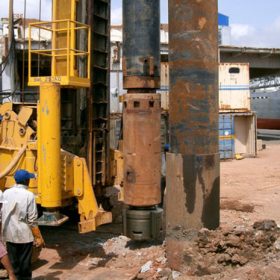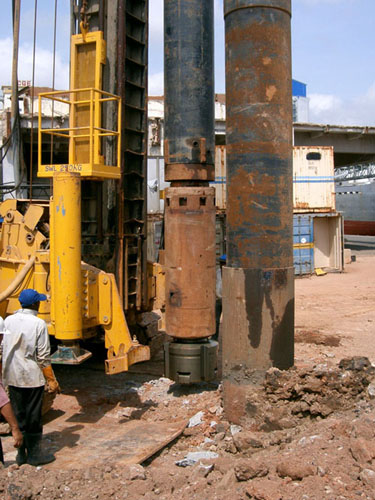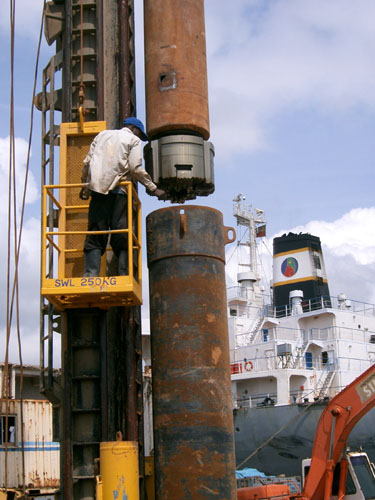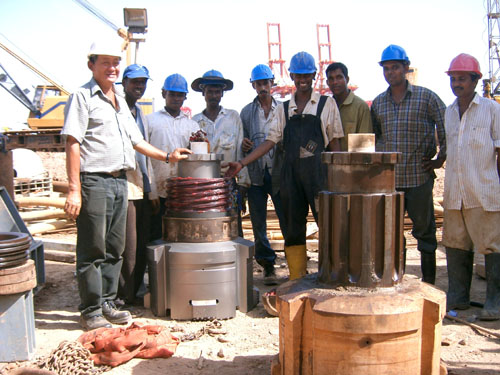
| Application | Piles for a dockside flour mill |
|---|---|
| Location | Colombo Port, Sri Lanka |
| Hammer | Numa 240 Hammer |
| Bit | Super Jaws® T710 Overburden Bit |
| Hole Size | Casing Size - 30 inch (762 mm), 0.374" (9.5 mm) and 0.402" (10.2 mm) wall |
| Depth or Length | 56 to 95 feet (17 - 29 m), single pass |
| Formation | Hard and abrasive granite gneiss boulders, unconsolidated fill containing occasional scrap steel |
| Rig Type | Nippon Sharyo DH508-105M piling rig converted to DTH |
Description
 The construction of Serendib Flour Mills (Pvt.) Ltd. Mill buildings and silos at the northern end of Colombo port required installation of 634 nominal 800 mm piles. The contractor, Sincon International (Pvt.) Ltd, commenced the project using a Bauer BG22 bored pile machine, which successfully completed 269 piles at good production rates. It became apparent that the boulders which were encountered at other pile locations were harder and tougher than anticipated, and the BG22 refused at those locations.
The construction of Serendib Flour Mills (Pvt.) Ltd. Mill buildings and silos at the northern end of Colombo port required installation of 634 nominal 800 mm piles. The contractor, Sincon International (Pvt.) Ltd, commenced the project using a Bauer BG22 bored pile machine, which successfully completed 269 piles at good production rates. It became apparent that the boulders which were encountered at other pile locations were harder and tougher than anticipated, and the BG22 refused at those locations.  Cores from boulders at three pile locations were tested at the University of Melbourne Rock Mechanics Lab. The results confirmed the boulders were hard at 160, 122 & 108 MPa, but also extremely abrasive. Results showed the formation to be more abrasive than 186 MPa Barre granite tested in the same lab.
Cores from boulders at three pile locations were tested at the University of Melbourne Rock Mechanics Lab. The results confirmed the boulders were hard at 160, 122 & 108 MPa, but also extremely abrasive. Results showed the formation to be more abrasive than 186 MPa Barre granite tested in the same lab.
The site location presented another challenge – the mill is located directly beside the breakwater at the northernmost end of the port. The pile design called for reinforced concrete piles, but seawater could be seen surging through cavities in the breakwater and into the site, and DTH cuttings included an assortment of seashells and lead fishing sinkers. It was concluded that the wave action must be surging through a large part of the site, which was confirmed by core drilling the DTH piles already completed. To overcome the obstacle, every DTH pile on the project would have to be cased.
After consideration of various methods to overcome the boulders and case the piles, the decision was made to use Numa’s Super Jaws Overburden Drilling System. Super Jaws is one of the best methods for simultaneously drilling and casing piles in unconsolidated ground  conditions of overburden, boulders, or bedrock. The bits utilize a unique design where wings extend out larger in diameter than the casing while in the drilling position. When drilling is completed, the bit is simply lifted off bottom, causing the wings to retract back into the guide body and all tooling can be brought back to the surface while leaving the casing in place. There is no reverse rotation required, nor any expensive rings left in the hole saving drillers time and money.
conditions of overburden, boulders, or bedrock. The bits utilize a unique design where wings extend out larger in diameter than the casing while in the drilling position. When drilling is completed, the bit is simply lifted off bottom, causing the wings to retract back into the guide body and all tooling can be brought back to the surface while leaving the casing in place. There is no reverse rotation required, nor any expensive rings left in the hole saving drillers time and money.
A suitable piling rig was available at the New Zealand contractor Daniel Smith Industries Ltd, and was converted to DTH drilling and shipped to the project. At the site, a Numa 240 hammer with Super Jaws T710 bits was used to install 30 inch (762 mm) casing with 0.374″ (9.5 mm) and 0.402″ (10.2 mm) wall. Each pile was drilled to a depth of 56 to 95 feet (17 – 29 m) in a single pass using the Numa drilling equipment. The overall project production rate based on the total metres drilled divided by the compressor engine hours was approximately 18 feet/hr (5.5 m/hr) making the project a success.


